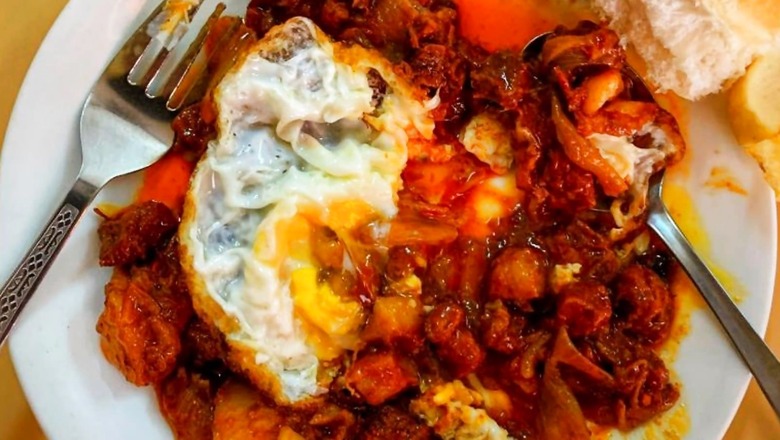
views
As Christmas draws closer, my obsession with pork doubles back faster than you can think of. Pork usually meant cold cuts at our home in the early 70s before imported meats were found in glistening delicatessens and luxury grocery stores as compared to how easily they are available today.
Before patisseries, fromageries and charcuteries, offered produit maison, curated gastronomy and exotic and cured meat from all over Europe, there was just the inevitable Cold Storage, like Shalimar at Peddar Road, Francoise Maison at Cumballa Hill, Farm Products at Bomanji Petit Road as well as behind the Taj Mahal Hotel and Café Galleries at Breach Candy. Displayed in their chillers were logs of pink marbled ham, long fat obelisks of speckled salami, loafs of luncheon meat, strings of frankfurters, heaps of cocktail sausages and rashers of bacon. Or if you wanted pork, there was the pork fellow in “Dukkar Galli” (pork lane) right next to Our Lady of Dolours Church, Sonapur. One of a row of shops with broken tiles, where freshly slaughtered carcasses hung on large iron hooks, where local aunties in floral dresses, and inebriated uncles in khaki shorts, came with their soggy cloth bags to bag some pink pig. You could also buy pork chops, back bacon, spare ribs, shoulder, side or loin. Pork Belly wasn’t as much a du jour delicacy as it is today, and the whole leg of ham was usually reserved for Christmas. But you could also get curry pieces with which you could cook up a great vindaloo or a pork curry. Of course, coming from a middle-class Hindu family, we hardly ever cooked pork at home, and I honestly think it’s because an Indian style pork curry was never in my grandmother’s repertoire and she just did not have a recipe. Although our refrigerator was always jam packed with ham, bacon sausages and salami. If you were very rich, then you could buy tinned meats like DAK branded sausages, and processed pork imported from Holland and other parts of Europe. But that was all well for sandwiches and breakfast. So, let me return to pork in its unprocessed form — meat and curry.
Vindaloo has always been my favourite pork dish. The first pork vindaloo I ever tasted was at a shack on Juhu Beach called Sea View Hotel. I must have been all of 10 and did not quite realise that this beachside restaurant with small rooms rented by the hour, enjoyed any other reputation, other than making the best Goan food ever. This flaming red curry, dripping with the heavenly fat of the pork, with the gusto of vinegar, red chillies and spices was unlike any Maharashtrian meat curry that I had ever eaten at home. Always partial to bread, for me, pork vindaloo and bread are like McCartney and Lennon, and I can’t imagine one without the other. But it’s the sorpotel that bewitched me. Perilously close to the Vindaloo but securely apart, the Pork Sorpotel is a stunning curry of somewhat Portuguese origin cooked by Goans, Mangaloreans and the East Indians of Mumbai. I say it was somewhat, because what was originally an offal laden dish made from the pig’s tail, ear, intestines, tongue and blood, cooked by African slaves in Brazil, embraced by Indians with great creativity and genius.
The name sorpotel comes from the Portuguese word ‘Sarapatel,’ which means confusion. Sarapatel is a Portuguese dish made with a bits and pieces of organ meat, a dish originating from Castelo de Vide in Alentejo, Portugal. Others say it’s a version of Sarrabulho, a traditional pork blood-based dish of the Minho Province, in Região Norte, Portugal. Wherever it may have originated, the way the local Goans transformed it with onion, spices and toddy vinegar, the sorpotel has left its Portuguese genealogy far behind.
Now the Goans, the East Indians and the Mangaloreans all make sorpotel. The East Indians who use their famed ‘bottle masala’ in the sorpotel claim their sorpotel is the best. Unlike the Goans who eat sorpotel with poie or sannas, the East Indians eat theirs with “fugias” (Deep fried balloon bread) or ‘hand bread’ or ‘appas’ (rice rotis). But let us not forget the Mangaloreans who also believe their sorpotel beats the hell out of the Goan or the East Indian versions. While the Goan Sorpotel most often includes just pieces of pork and the pig’s liver, the Manglorean version also known as “Kaleez Ankiti” often includes all the organ meat of the pig including Kaleez (heart) and Ankiti (intestines). There is no better Manglorean sorpotel than the one my old friend Prema Menezes used to make. There was a time when I was obsessed with not only her, but with her cooking as well. Her father’s kitchen in their Dadar home produced the choicest of Manglorean sukkas and curries. Years later, I visited her on an extended holiday when she lived in Sydney, Australia and tired of western food we decided that she would cook up some of her acclaimed Sorpotel. Fundamental to the making was the hunt for ingredients. It was only in faraway Cabramatta, a New South Wales suburb with a substantial Vietnamese and Asian population, we found the right offal and coagulated blood to add to the pork. The rest was arduous, especially the cutting of pork into really small pieces. Spiced, pickled, cooked and ready, the sorpotel was exigently put away in the refrigerator for three days, till it had time to mature into a heady, complex and cultured curry. Though I did steal a few bites in between, it was worth the wait.
Chef Hussain at Mumbai’s O Pedro, on their Christmas menu does a superlative Goan sorpotel, bright red, tangy, spicy, he keeps a huge cauldron for over a week, heating it up and cooling it every day, till the sorpotel has aged and till the meat had imbibed and absorbed every bit of spice and vinegar. With hot steamed toddy spiked and gently sweet “sannas’, this flaming curry is just hog heaven. But how can I forget New Martin Hotel, Colaba. My haunt since my college days. At this Goan restaurant, which I suspect is owned by Mangaloreans (I may be wrong), Sorpotel is a Saturday Special. It is served in a flat saucer, small pieces of pork, fat and liver in an intense, vinegary red masala, I often request them to top it with an egg, fried sunny-side-up, with a runny yolk. That with ‘garam pav’ from the next-door bakery to me indeed turns me into a pig.
Kunal Vijayakar is a food writer based in Mumbai. He tweets @kunalvijayakar and can be followed on Instagram @kunalvijayakar. His YouTube channel is called Khaane Mein Kya Hai. The views expressed in this article are those of the author and do not represent the stand of this publication.
Read all the Latest Lifestyle News here



















Comments
0 comment